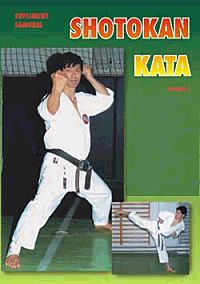 Japanese Language online course. Japanese Language online course.
For information please email us or complete the form in the contact page.
|
|
 |
| |
 Shotokan Kata Shotokan Kata
volume I
Author: Neculai Amalinei
A 92 Publishing House, Iasi, 2000.
128 pages, 210x297 mm
ISBN: 973-9476-18-X |
 |
In the practice of Karate, an instructor is supposed to teach Kata (formal exercises), Kihon (basics) and Kumite (sparring).
Traditionally, the practice of Kata was the fundamental element in teaching the art of Karate Do.
Kata is not practiced only for a self-defense drill, but for self reflection, concentrated improvement and searching perfection of each movement, too.
In the first volume there are introduced the following Kata: Heian Shodan, Heian Nidan, Heian Sandan, Heian Yondan, Heian Godan, Tekki Shodan and Bassai Dai.
They were taught at the practical course of Shotokan Karate Do.
(The Author)
KATA
Japanese karate Kata came from the island of Okinawa, and in turn Okinawan karate Kata came from China.
Traditionally, Japanese karate practiced Kata mainly for their techniques. Through Kata practice one can almost perfect his karate technique. The ideal state of having good balance, speed, power, the combination of slow and fast motion and breathing - all those things can be learned through Kata.
Nowadays, there are many karate competitions in which sometimes contestants lose the true sense of karate.
I am sorry to say that we do not see techniques of real such as powerful kicking. This does not mean however you have to insist on just power.
Shotokan Kata should be performed beautifully, like a Kumite match, not only with speed and power, but also with an expressive performance.
I think it is the most important of Karate to train one's mind, rather than just train one's technique.
Before you perform your Kata (ZENSHIN), control your mind.
During Kata performance do not put out too much power, do not be too relaxed. Even though your actions may be violent, your mind should be controlled, full of spirit (TSUSHIN). Your mind should be enriched, without any idle thoughts (ZANSHIN).
This is an extremely difficult thing to achieve. Twice I have had the experience of not recognizing the audience or judges at all, I felt like I was attaining a spiritual state of perfect selflessness, so much that I was out of breath or even slightly tired.
I have been practicing karate for quite sometime, but as I said I have only experienced this feeling twice so far. I continue to practice every day so I might have this feeling again.
It has been my experience it is more difficult to practice Kata than Kumite. Remember it is not only what other people think about your Kata, but what you think about your performance.
Kasuya Hitoshi Sensei
8th Dan
Chief Instructor of World Shotokan Karate Do Federation
Japan |
|
|